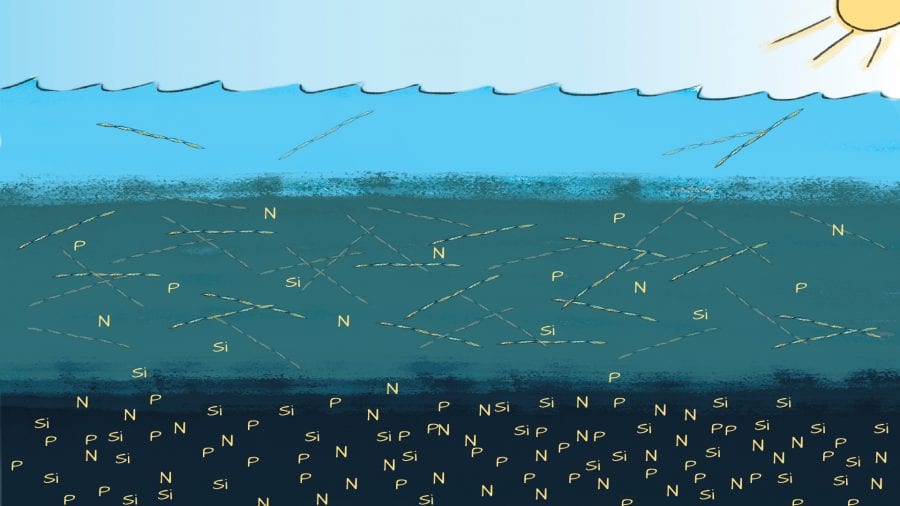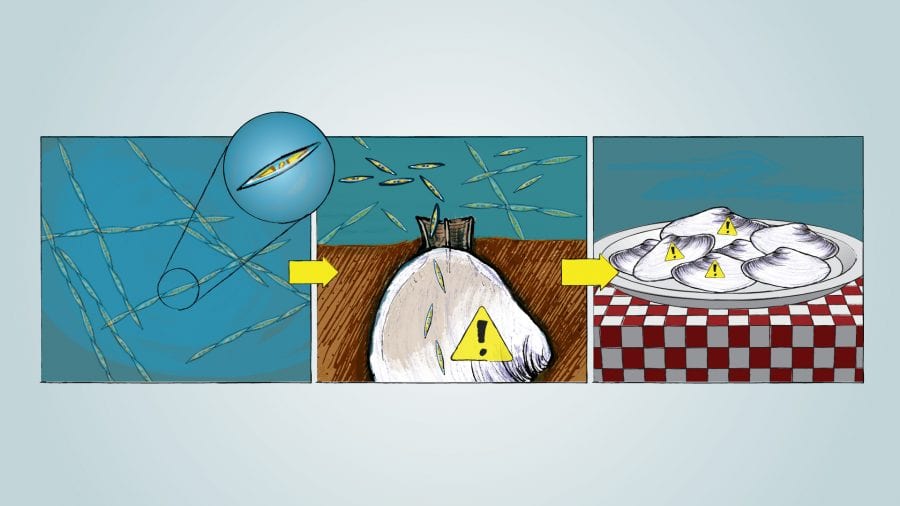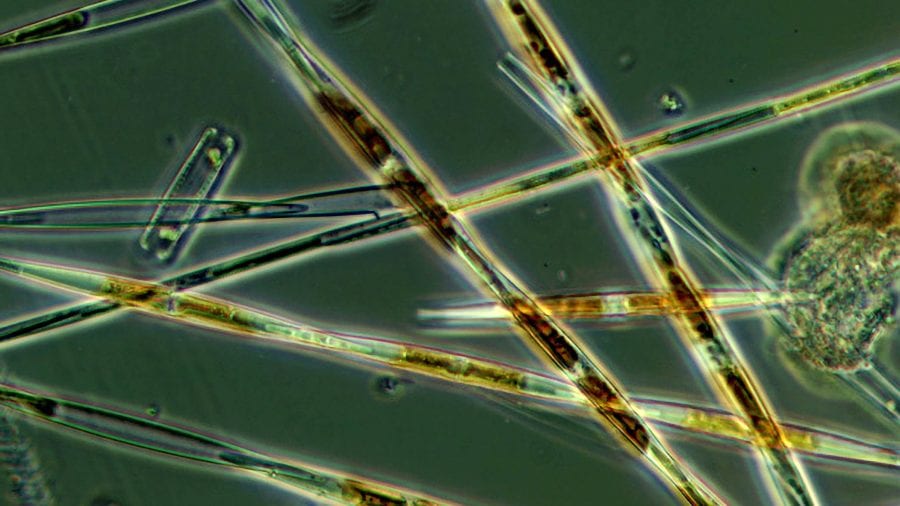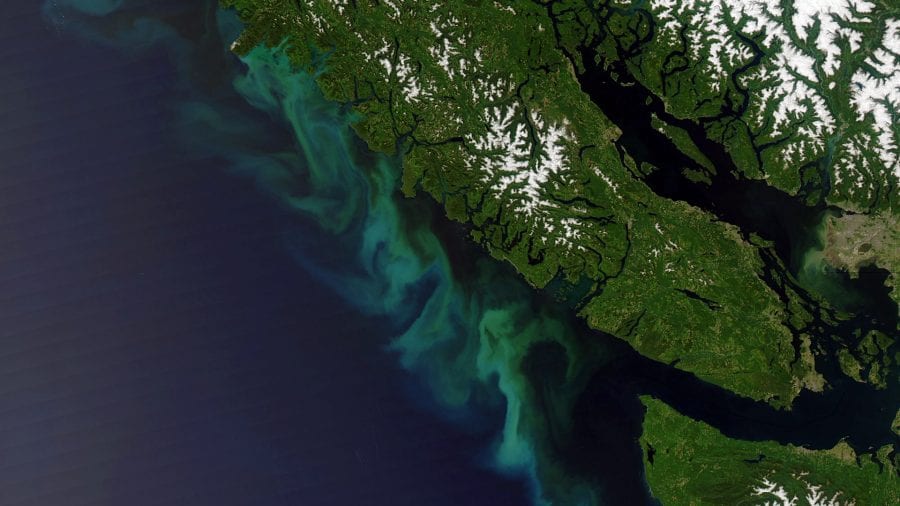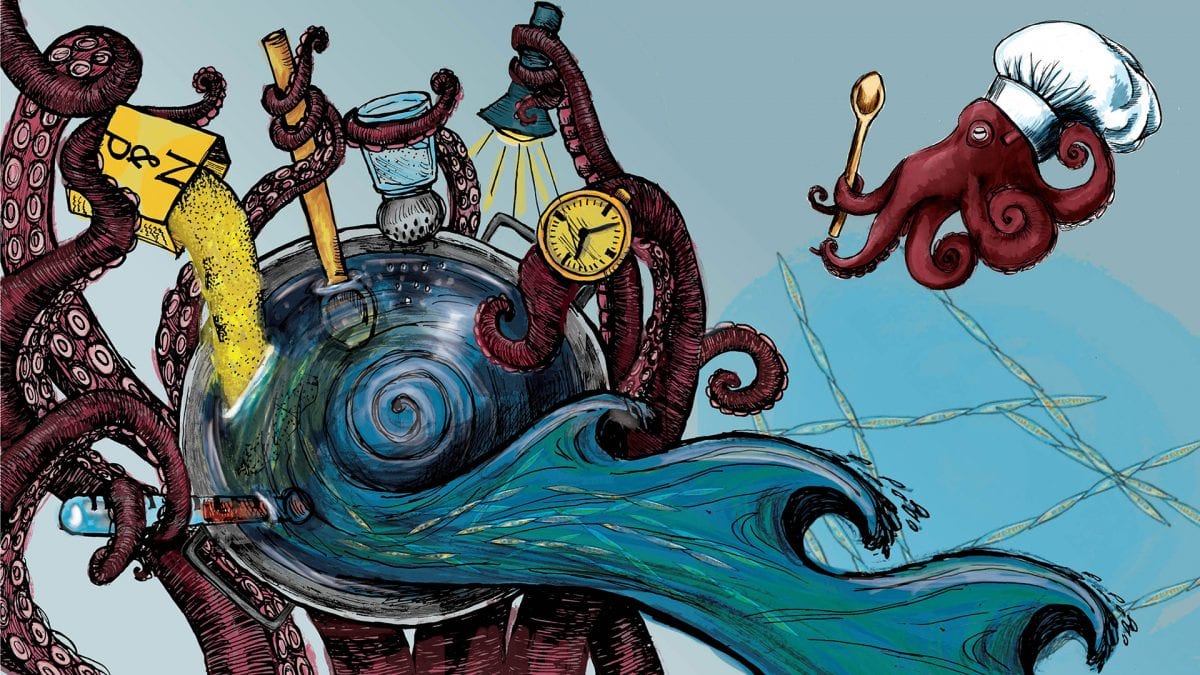
The Recipe for a Harmful Algal Bloom
Many ingredients mix in the ocean to make toxic shellfish
In 2015, 239 poisoned sea lions washed ashore on the California coast. The culprit? A single-celled organism one-tenth the width of a human hair.
The microscopic organism is a tiny cell with a long Latin name: Pseudo-nitzschia. On its own, one Pseudo-nitzschia cell is harmless. But just as a hoard of ants can overrun your blanket and ruin your picnic, when tens of thousands of Pseudo-nitzschia grow quickly and concentrate in an area, they can poison seals, otters, dolphins, whales, and even people. The phenomenon is an example of a “harmful algal bloom,” or HAB.
When Pseudo-nitzschia bloom, they sometimes produce a neurotoxin called domoic acid. Shellfish eat the algae and accumulate the toxin in their tissues, and when humans and marine mammals eat the shellfish, they can get sick, and in some cases, die.
One day in 1961, hundreds of crazed seabirds dove into lampposts and attacked residents of the idyllic seaside town of Capitola, California. The event inspired Alfred Hitchcock’s infamous movie, “The Birds,” but only several decades later did scientists realize that the seabirds may have been poisoned by domoic acid produced by Pseudo-nitzschia.
In 1987 on Prince Edward Island, Canada, hundreds of people got sick and three people died because they ate mussels contaminated with domoic acid. Since then, Pseudo-nitzschia HABs have increased in strength and frequency worldwide: They occur more often, in more locations, and for longer periods of time, leading to greater economic losses.
Everyone from scientists to fishermen, politicians, and beachgoers wants to prevent damage caused by HABs. So do I.
At the moment, the best practice for preventing shellfish poisoning is to regularly test shellfish for domoic acid and close entire shellfisheries when concentrations go above a set limit. Such closures can have devastating impacts for shellfish farmers, restaurants, consumers, and coastal tourism. In 2015, shellfish fisheries along the entire U.S. West Coast, including oysters, razor clams, and mussels, were shut down for months. The 2015 and 2016 Dungeness crab seasons in California were declared natural disasters, and state representatives requested $138 million in disaster relief funds from the federal government.
This approach is reactive, not proactive. I want to do better. I want to help figure out when, where, and why these algae grow so quickly, and when, where, and why they produce toxins. Once we’ve answered these questions, we can begin to predict Pseudo-nitzschia blooms, give fishermen advanced warning, and prevent illnesses and shellfish closures.
Picky eaters
Pseudo-nitzschia are phytoplankton—single-celled organisms drifting in the ocean that use photosynthesis, just as plants do, to make their food. They need light, nutrients, and the right water temperatures to survive. So to predict a bloom, you might think it’s as simple as predicting where there will be plenty of light and nutrients and the perfect temperature. This is good in theory, but the reality is far more complicated.
Each harmful algal species, including those in the group Pseudo-nitzschia, occupies its own corner of the ecological marketplace. But there are many species of Pseudo-nitzschia, and each likes a different environment and follows its own recipe for light, nutrients, and temperature. To complicate matters even further, not every species of Pseudo-nitzschia is toxic, and not even the toxin-producing species are toxic all the time. So how do we begin to understand what causes a bloom and what makes it toxic?
The easiest factor to investigate is the availability of nutrients, which all organisms require in some form or another. Humans get nutrition from eating plants and other animals, but phytoplankton prefer nutrition in its most basic form: as nitrogen or phosphorus.
Typically, increasing the amount of these nutrients in seawater leads to more phytoplankton. Unfortunately, it’s not as straightforward for HABs. Freshwater harmful algae like more phosphorus, saltwater harmful algae like more nitrogen, Pseudo-nitzschia demand silica, and some species are picky enough to prefer specific ratios of one element relative to another.
Next we investigate light. Just like a house plant grows best when placed near a window, most phytoplankton species grow best near the ocean surface, where sunlight is plentiful. But not all phytoplankton want the same amount of light.
Consider a cactus. It’s native to the desert and thrives under twelve hours of direct sunlight. Now consider an orchid. If it were placed in the same environment where a cactus thrives, it would shrivel under the sun’s glare.
In the same way, not all phytoplankton want to grow in the height of summer or right at the water’s surface. Some prefer spring or fall, and some like waters that regularly mix, so they can be carried out of and back into the sunlight in routine intervals. To predict Pseudo-nitzschia blooms, we have to know where each species falls on this spectrum of “light-lovers.”
Factors beyond their control
The ocean itself also can affect Pseudo-nitzschia growth. Most organisms grow more in warmer temperatures, but at a certain point, the water can become too warm, and the phytoplankton will start to die. So we look for just the right temperature.
Each species also has a range of saltiness that it can tolerate. So we have to consider rain and rivers that add more fresh water and dilute seawater salinity.
And ocean currents transport floating objects such as phytoplankton. So we also analyze where the blooms come from and where they go.
There are biological factors to consider as well. How do species compete with one another? How do larger marine life prey on smaller animals? How do complex life cycles of reproduction, growth, death, and regrowth interact?
And what actually triggers the cascade that results in a bloom? It depends. Sometimes it’s wind; sometimes it’s nitrogen. It can also be temperature, light, or salinity. Essentially any one of these growth factors can be the main factor controlling the timing and location of a bloom.
Is your head spinning yet?
A recipe for disaster
Understanding harmful algal blooms is a bit like trying to replicate Grandma’s stuffing without the recipe—we have to re-create the dish knowing only the end result and a few main ingredients.
Fortunately, we know a lot about the recipe from scientists who have studied Pseudo-nitzschia. For example, some scientists have found that certain Pseudo-nitzschia species grow in salty waters with temperatures of 50 to 64 degrees Fahrenheit (10 to 18 degrees Celsius). But if the waters become too cold or fresh, the plankton can’t grow or reproduce.
They also seem to grow well where nitrogen is abundant. This means they’re more likely to bloom in coastal regions, where winds can push low-nutrient waters offshore, bringing up high-nutrient waters from the deep to the surface to replace them. So far, Pseudo-nitzschia blooms have been observed mostly in these so-called “upwelling zones.”
Other scientists have spent years observing the same few square miles of water to see how ocean currents might affect blooms. Off the coast of Washington State, surface waters predictably flow in a circle, trapping nutrients and plankton in the center and creating perfect conditions for Pseudo-nitzschia to produce domoic acid. If waters carrying toxic Pseudo-nitzschia happen to break away from the center and flow to the coast, it can signal the end of the razor clam harvest for that year.
A similar phenomenon occurs near Santa Barbara, Calif., where surface currents push together more dispersed but already toxic cells. That concentrates existing toxins and turns a non-bloom situation into a bloom.
These are all great examples of research that is untangling the causes of Pseudo-nitzschia HABs. But that’s only half the battle: How can we improve our ability to predict blooms?
To predict blooms, scientists use what we call models. These are essentially a series of equations whose variables are the different growth factors I already described. The equations describe how the nutrients, ocean currents, and Pseudo-nitzschia growth relate to one another to produce a HAB.
To build a model, we start with the most basic processes, such as photosynthesis or an ocean current. Later we might add in more detailed factors, such as predator-prey interactions, for example. We run the model, and if it reliably reproduces what we observe in reality in the ocean, we add in another factor and see if we can make the model even more accurate. If it is, we can plug real-time observations into the models to predict what may unfold in the coming days and weeks.
Work with what you’ve got
I’m not yet ready to build and test my own model, because I am still exploring my data and trying to deduce the recipe for Pseudo-nitzschia growth. The data I am analyzing come from water samples collected on ocean cruises and by autonomous measurement platforms anchored offshore. I have information about ocean temperature and salinity, wind speeds and directions, Pseudo-nitzschia abundance, water clarity, and nutrients.
I am plotting my data and looking for patterns to identify and clarify the key growth factors and processes that spawn Pseudo-nitzschia HABs. These patterns can exist in time, such as when a bloom occurs only in the summer. Or they can exist in space, such as when one species grows closer to shore and another species grows offshore.
By comparing the number of Pseudo-nitzschia cells in the water samples to the many different growth factors, I can see that some of my cells grew more in waters that are relatively salty and have specific ratios of nutrients. These cells are picky and don’t just want an abundance of nutrients, but specific amounts of one relative to another. So when I’m building my model, I’ll start there: Which salinity and nutrient conditions do these Pseudo-nitzschia need to grow?
Next, I will use what I know about the physics of the ocean to predict when and where the right conditions will happen. For example, the water that flows into the Gulf of Maine from the Atlantic Ocean influences the temperature and salinity of water where HABs occur. I also have an idea that this water might have transported Pseudo-nitzschia cells to the location where we measured high toxin levels. This is just one of several processes we have to consider to understand the factors surrounding a HAB.
All these factors offer reasonable explanations for why the HABs happened, which is the question we hope to answer before zooming in to predict when and where we think a HAB will occur.
We’re used to predictions in the world of weather, but oceanographers make predictions too. Just as meteorologists are able to give advanced warning of an approaching hurricane, I want to be able to give advanced warning of a HAB, so that infinitesimal organisms don’t become colossal problems.
This research is funded by the Woods Hole Center for Oceans and Human Health, which is jointly funded by the National Science Foundation and the National Institute for Environmental Health Sciences.
From the Series
Slideshow
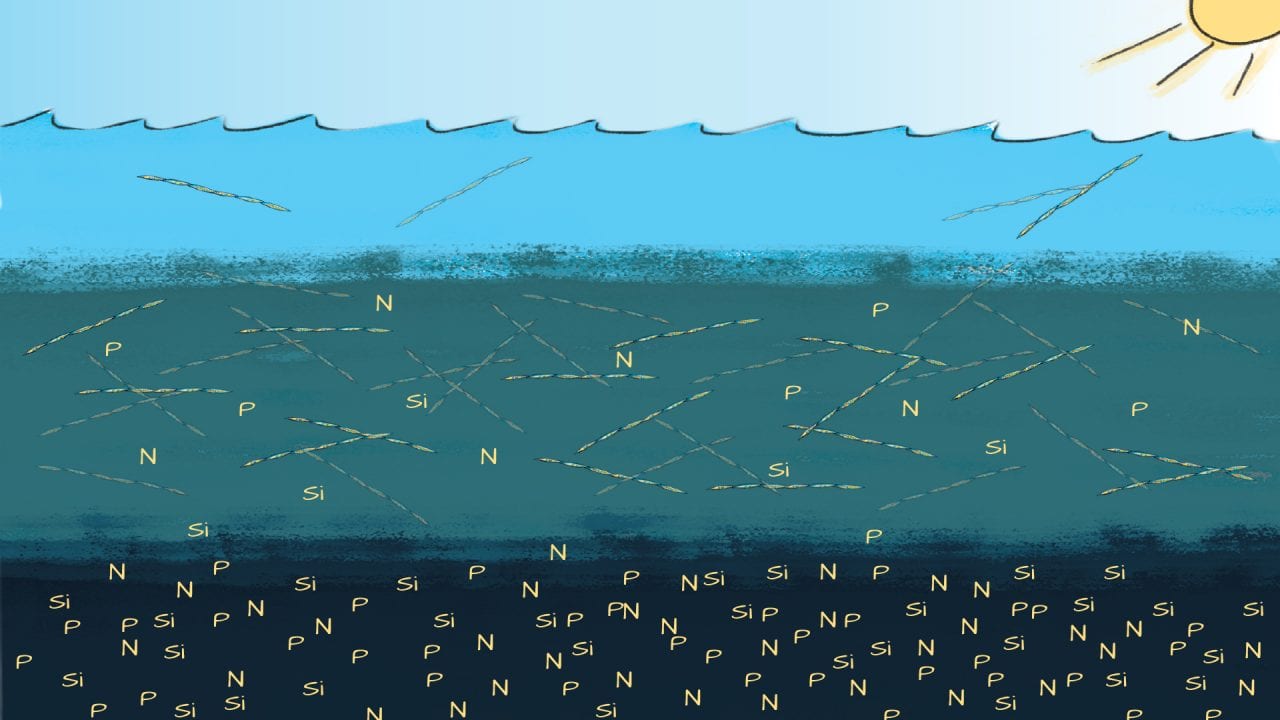
Slideshow
- Phytoplankton, including harmful algae, need the right combination of ingredients to grow. They need sunlight, which is bright near the surface but gets dimmer with depth. They need nutrients, which are plentiful in dark, deep waters but scarce near the surface. One example of a "sweet spot" for peak phytoplankton growth occurs a few meters below the surface, where they have enough of both nutrients and sunlight. (Natalie Renier, Woods Hole Oceanographic Institution)
During a bloom, Pseudo-nitzschia float everywhere in the water. Filter-feeding shellfish such as clams indiscriminately suck in large volumes of water containing toxin-containing Pseudo-nitzschia. If we harvest and cook these shellfish, the toxins end up on our plates.
(Natalie Renier, Woods Hole Oceanographic Institution)A light microscopy image of Pseudo-nitzschia australis, a known toxin-producing Pseudo-nitzschia species.
(NOAA Northwest Fisheries Science Center)A satellite image shows a Pseudo-nitzschia bloom off the coast of Washington State. Harmful algal blooms like these can shut down shellfisheries for months.
(NASA)

